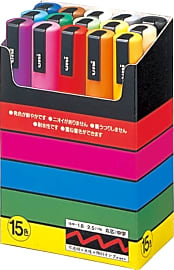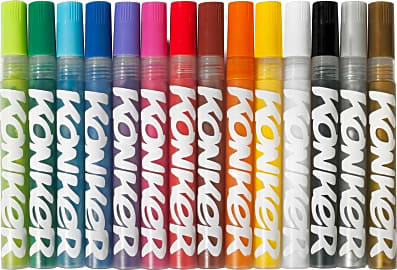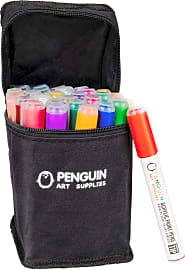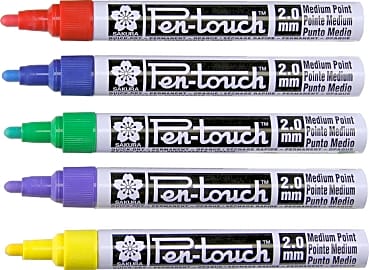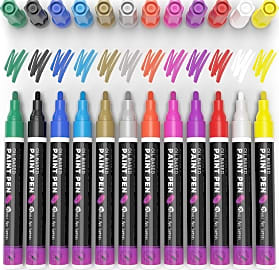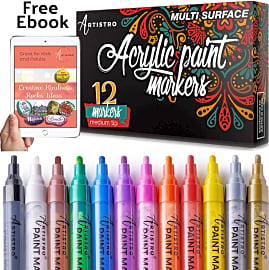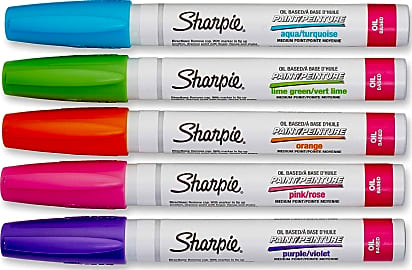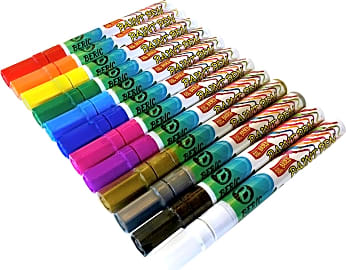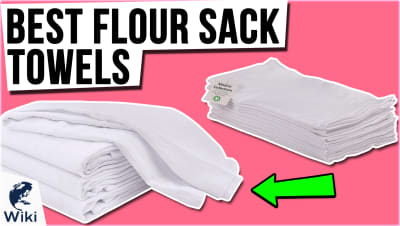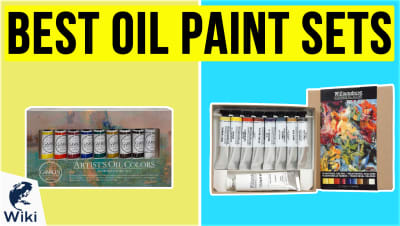The 10 Best Paint Markers

This wiki has been updated 34 times since it was first published in April of 2018. Unlike standard or permanent options, these paint markers can be used on a wide range of surfaces, such as metal, stone, rubber, and glass. They're popular for writing advertising copy on the windows of businesses and restaurants, as well as for outdoor art applications. Remember that, just like a can of spray paint, you need to shake them before using in well-ventilated areas only. When users buy our independently chosen editorial choices, we may earn commissions to help fund the Wiki.
Editor's Notes
July 22, 2020:
Our latest update saw the removal of the Mincho Metallic, which became unavailable, and the PaintMark Oil. The PaintMark brand is satisfactory enough, but in a category with dozens of exceptional offerings, we felt they weren't a strong enough contender to stick around. We supplanted them with the Penguin Art Supplies Dual, which are similar in price but come with nearly double the amount of markers. They're also outfitted with dual-ended tips that you can easily swap between for different uses, and come with a zippered carrying case. They use nontoxic paint and are sized so that they don't feel too bulky in small hands, making them suitable for children as well as adults.
Like our previous note explains, some of these options need to be used in ventilated areas and cured on certain surfaces for permanence. We maintained a balance between oil-based options like the Sharpie Medium, water-based ones like the well-loved Mitsubishi Pencil Uni Posca, and acrylic paints such as the newly added Molotow One4All Basic. The Molotow brand, along with Konker Permanent, offer artist-grade pigments and are priced to reflect that. The Markal Quik Stiks are also of professional quality, however, they're best used for making markings in industrial spaces.
If you're looking for an affordable set to paint on everything from rocks, drinking glasses, and mugs to windows and clay, the Artistro Acrylic, Sharpie Medium, and Beric Assorted are all serviceable choices.
June 14, 2019:
Before talking about current top picks, we'd just like to briefly point out two things about paint markers. First, oil-based options are best used in a ventilated room so you aren't breathing in any fumes. Second, you may need to (cautiously and safely) bake or otherwise heat your project or add a protective clear coat if you need true permanence. How well the paint withstands washing and wear will depend on the surface's finish, as well, so you might experiment before you get started.
When it comes to sets that are long-lasting and useful for a range of products, the Konker Permanent and Mitsubishi Pencil Uni Posca remain top-notch options. The former set comes with 14 markers while the latter offers 15, which is enough color choice to get started in rock decorating, gear customization, and similar. Neither is particularly cheap, but you can expect to get more use out of them than most ultra-low-budget options. There's also the Sharpie Medium; you are almost certainly familiar with the brand, and their paint markers live up to their reputation. It's worth noting, though, that some users feel that the paint scratches more easily than some other options. Much of this is down to the actual surface that's being written on and the care it receives, so you might want to play around with them before you start any serious projects. Finally, we removed the Artiqo Set over issues with the pens exploding, which can ruin a project. For a similar budget-friendly option, you might consider the Castle Art Supplies Vibrant. They aren't great for finely detailed work, but they're inexpensive and vibrant enough.
Special Honors
Montana Cans Refills Going through a considerable amount of paint? Then you might want to check out the Montana Cans Refills, which are empty markers you can pair with their line of paints for a flexible, customized experience. They offer plenty of colors to select from, including fluorescents, as well as markers with variously sized tips. montanacans.com
Fantastix Absorbent Coloring Tool If you like to amass specific colors in a personalized palette, consider grabbing these applicators from Fantastix. They feel natural in the hand, are easy to control, and are ideal for use as a coloring tool or ink-ready marker. Dip the nib into water or solvent-based liquid inks to pull the ink into the barrel. Offered with bullet or conical tips, they feature absorbent fibers that allow for precise application and can be reshaped by cutting. imaginecrafts.com
Making Your Mark
Outside of writing sales and advertising copy on the window of a restaurant or business, paint markers are suitable for a number of projects.
Outside of writing sales and advertising copy on the window of a restaurant or business, paint markers are suitable for a number of projects. You can use them to draw, paint, and stencil designs over almost any surface. That includes rubber, glass, fabric, wood, metal, stone, and more. With a quality set of paint markers in hand, the world is your oyster.
If you're the creative type, then you'll be happy to know that paint markers provide near-infinite possibilities for crafting. Use them to hand letter names or sketch motifs over plates, bowls, and mugs. You can even permanently bake oil-based inks onto glass and ceramic, allowing you to drum up party favors, wedding keepsakes, and personalized gifts with ease.
If you've got old pillows or flour sack towels lying around, you can give them new life with a simple print or your initials. You can transform a plank of wood into a fun new sign for your home or business, jazz up your houseplants by decorating their pots, or take part in the age-old hobby of rock art. If you're confident enough and have a steady hand, you can even decorate your walls.
Paint markers are not just the domain of the creative. They can be put to practical use in industrial spaces, as well. Because they're reliably water- and fade-resistant, you can use them to apply measurements and label supplies at a worksite. They'll leave bright, permanent marks on steel, iron, aluminum, plastics, and composites. Many inks can withstand extreme temperatures, so you can rest assured that your work isn't going anywhere.
Choosing The Best Marker Set For You
You don't have to be Vincent Van Gogh to create works of art if you have a solid set of paint markers at your disposal. They're extremely versatile and come in plenty of colors, which not only makes them suitable for creative pursuits but for practical purposes, as well. Before you go purchasing a set, though, it's important to consider a few key factors. That way, you'll have the best tools for the task at hand.
One of the most important components of a paint marker is the nib. This is the spongey, porous tip that rests above the ink reservoir. Ask yourself if your project requires broad strokes, fine lines, or the filling in of large spaces. If you'll be doing all three, look for markers with a medium-sized tip. These can depict moderate details and fill in wide areas with little effort, not to mention make quick work of a large storefront display. If you're working on projects that require thin, intricate strokes, it may be better to choose a marker pen with a small, sharp tip.
The nib should facilitate uniform ink flow and come with a tightly fitting cap to prevent it from drying out. If you're often frustrated by markers that roll away once you set them down, look for anti-roll caps. These covers won't be entirely circular, and will instead sport small ridges that keep them in place.
Arguably more important than the nib is the ink your markers use. Up until the 1990s, many inks contained solvents like xylene or toluene to keep them from coagulating. These chemicals throw off volatile organic compounds — commonly known as VOCs — which can cause respiratory and immune issues in small children, as well as eye, nose, and throat irritation in adults. And that's not counting the myriad other ailments to which they've been linked.
These days you'll find that most companies use strictly nontoxic water or oil-based inks, but it's still smart to double check that they don't incorporate other harsh chemicals. Not only is nontoxic ink better for your health, but it's also helpful if you're sensitive to strong odors or prone to headaches.
Once you've confirmed your ink is nontoxic, you'll want to ensure it ticks a few more boxes. It needs to be highly-pigmented and long-lasting. It should be opaque so it shows up on both dark and light surfaces. Many inks will also resist fading in UV light, which is helpful if you're decorating a window or creating outdoor art. As a rule, water-based inks are easier to wash off with some effort, while the oil-based variety will require a stronger removal solution and a bit more elbow grease.
A Brief History Of The Marker
While charcoal and paint have stained the hands of artists for thousands of years, the humble marker is a relatively recent invention. Things kicked off in 1910 when Lee Newman patented his felt-tipped marking pen. Newman had high ambitions when it came to his newly created writing device. He broadly claimed that consumers should employ it "in any case where it is desired to spread a relatively broad line of liquid upon a receiving surface."
It featured special compartments capable of holding multiple colors of ink and used a soft sponge for its tip.
He also intended that factory and postal workers might use it to mark packing boxes and package freight, and for canceling stamps. His invention was simple and resembled the markers we use today, but it didn't exactly fly off the shelves.
About a decade or so later, in 1925, Benjamin Paskach filed a patent for his fountain paintbrush. It featured special compartments capable of holding multiple colors of ink and used a soft sponge for its tip. It was meant for both artistic and general purpose use, but sadly, it wasn't commercially viable either.
In 1953, Sidney Rosenthal began marketing his magic marker to the masses. It sported a glass tube and wool felt wick, and Rosenthal touted it for its magical ability to write on any surface. It was a hit.
Within a few years, it was common practice to use a felt-tipped marker for everything from creating posters to various labeling and lettering projects. Building on that success, Yukio Horie of the Tokyo Stationery Company contributed the fiber-tipped pen — which was better for creating thin, fine strokes — in 1962.
After a few more decades of tweaks, developments, and trademarking, markers split into a handful of categories. By the end of the 1990s, you could choose between permanent markers, highlighters, dry-erase markers, fine-line markers, and, of course, paint markers.


